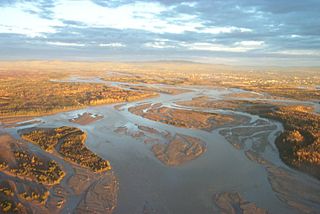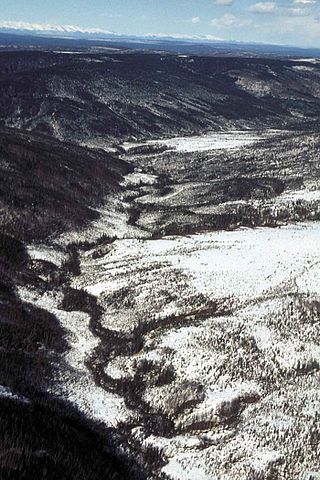Related Research Articles

Interior Alaska is the central region of Alaska's territory, roughly bounded by the Alaska Range to the south and the Brooks Range to the north. It is largely wilderness. Mountains include Denali in the Alaska Range, the Wrangell Mountains, and the Ray Mountains. The native people of the interior are Alaskan Athabaskans. The largest city in the interior is Fairbanks, Alaska's second-largest city, in the Tanana Valley. Other towns include North Pole, just southeast of Fairbanks, Eagle, Tok, Glennallen, Delta Junction, Nenana, Anderson, Healy and Cantwell. The interior region has an estimated population of 113,154.

Yukon–Koyukuk Census Area is a census area in the U.S. state of Alaska. As of the 2020 census, the population was 5,343, down from 5,588 in 2010. With an area of 147,842.51 sq mi (382,910.3 km2), it is the largest of any county or county-equivalent in the United States, or about the same size as the entire state of Montana. It is part of the unorganized borough of Alaska and therefore has no borough seat. Its largest communities are the cities of Galena, in the west, and Fort Yukon, in the northeast.

Tanana is a city in the Yukon-Koyukuk Census Area in the U.S. state of Alaska. At the 2010 census the population was 246, down from 308 in 2000. It was formerly known as Clachotin, adopted by Canadian French.

The Tanana River is a 584-mile (940 km) tributary of the Yukon River in the U.S. state of Alaska. According to linguist and anthropologist William Bright, the name is from the Koyukon (Athabaskan) tene no, tenene, literally "trail river".

Department of Alaska was the designation for the government of Alaska from its purchase by the United States of America in 1867 until its organization as the District of Alaska in 1884. During the department era, Alaska was variously under the jurisdiction of the U.S. Army, the U.S. Dept. of the Treasury and the U.S. Navy. The area later became the District of Alaska, then the Territory of Alaska, then the State of Alaska.

The Kuskokwim River or Kusko River is a river, 702 miles (1,130 km) long, in Southwest Alaska in the United States. It is the ninth largest river in the United States by average discharge volume at its mouth and seventeenth largest by basin drainage area. The Kuskokwim River is the longest river system contained entirely within a single U.S. state.

The Koyukuk River is a 425-mile (684 km) tributary of the Yukon River, in the U.S. state of Alaska. It is the last major tributary entering the Yukon before the larger river empties into the Bering Sea.

The Nenana River is a tributary of the Tanana River, approximately 140 miles (230 km) long, in central Alaska in the United States. It drains an area on the north slope of the Alaska Range on the south edge of the Tanana Valley southwest of Fairbanks.

The Kuskokwim Mountains is a range of mountains in the Yukon-Koyukuk Census Area, Alaska, United States, west of the Alaska Range and southeast of the Yukon River. The Kuskokwim Mountains begin in the interior west of Fairbanks. The mountain range extend from Canyon Creek and Chikuminuk Lake in the southwest over a distance of about 400 km (250 mi) long to the Tanana River in the northeast and reach a width of up to 80 km (50 mi).

Mount Hayes is the highest mountain in the eastern Alaska Range, in the U.S. state of Alaska. Despite not being a fourteener, it is one of the largest peaks in the United States in terms of rise above local terrain. For example, the Northeast Face rises 8,000 feet (2,440 m) in approximately 2 miles (3.2 km). This large vertical relief contributes to Mount Hayes being the 51st most topographically prominent peak in the world.

The White Mountains is a 71-mile (115 km) mountain range in the Yukon-Koyukuk Census Area of the U.S. state of Alaska. It lies between Beaver Creek and Preacher Creek, and was named by prospectors for its composition of white limestone. The range reaches a maximum elevation of 3,176 feet (968 m). Some of the range is located in the White Mountains National Recreation Area, a 1-million-acre (4,000 km2) wilderness just 30 miles (48 km) north of Fairbanks. The White Mountains and Ray Mountains together constitute the Yukon-Tanana Uplands, an area of low mountain ranges and high ground in Interior Alaska.
The Chatanika River is a 128-mile (206 km) tributary of the Tolovana River in the U.S. state of Alaska. The Chatanika River is a clear or lightly tannic stained rapid-runoff stream that has its headwaters in the White Mountains and flows westward through valleys between summits and uplands for about four-fifths of its length before it enters Minto Flats. Once in the flats—a marshy area in which multiple streams, rivers, and lakes are located— the Chatanika joins the Tolovana, which flows into the Tanana River and on to the Yukon River. The Chatanika is thus a portion of the Yukon River drainage basin.

Rampart Canyon, Rampart Gorge, Lower Ramparts, and The Ramparts all are names for a high-banked canyon of the Yukon River located downstream of Rampart, Alaska and upstream of Tanana, Alaska. The canyon is located at an elevation of 226 feet (69 m) and was the considered site of a hydroelectric dam.

Mount Prindle is a granitic mountain in the Yukon–Tanana Uplands, and is located approximately 45 miles (72 km) north-northeast of Fairbanks, Alaska. The plutons that form the core of the Mount Prindle massif are Late Cretaceous or early Tertiary age. These plutons intruded older metamorphic rocks. Mount Prindle exhibits classic glacial landforms, unlike most of the surrounding Yukon–Tanana Uplands. It is in the Circle Mining District and many of the surrounding creeks have been or are being mined for placer gold. The area has also been prospected for tin and rare earth minerals. Mine roads and hiking trails provide access to the mountain. A 900 feet (270 m) granite wall on an eastern spur of the massif is an attraction for rock climbers.

Kanuti National Wildlife Refuge is a national wildlife refuge in central Alaska, United States. One of 16 refuges in Alaska, it was established in 1980 when Congress passed The Alaska National Interest Lands Conservation Act (ANILCA). At 1,640,000 acres (6,600 km2), Kanuti Refuge is about the size of the state of Delaware. Located at the Arctic Circle, the refuge is a prime example of Alaska's boreal ecosystem. It is dominated by black and white spruce, with some white birch and poplars.

The interior Alaska–Yukon lowland taiga is an ecoregion in the taiga and boreal forests biome, of far northern North America.
John Bremner (1833–1887) was a prospector and early explorer of Alaska.
Arthur Harper (1835–1897) was an Irish-born Yukon River prospector, trader, and explorer, recognized as the first man to enter the Yukon country seeking gold. He mined in California during the 1850s, and British Columbia during the 1860s, before travelling to the Yukon region in 1871. He reached Fort Yukon in 1873, and managed a store with Jack McQuesten at the Fortymile River. Harper formed a trading partnership with McQuesten and Captain Al Mayo; their company founded Fort Reliance in 1875 and other posts in the Yukon region. Harper was known as the best prospector of the trio, and while he did not achieve major success in his pursuit of gold, he sometimes directed others to finds. He traded and prospected in Alaska until just before his death.

The Interior Yukon-Alaska alpine tundra ecoregion covers alpine, sub-alpine, and boreal forest areas along the cordillera of Interior Alaska and south-central Yukon Territory. Geologically, they are the disjunct uplands of the Yukon-Tanana Terrane plus a southern extension of the Brooks Range. The cover is extensive 'dark taiga' of closed spruce forest, open forest of other species, and alpine vegetation at higher altitudes. The region is mostly wilderness and relatively untouched by human development.
References
- ↑ Donald J. Orth. Dictionary of Alaska Place Names Washington, D.C.: U.S. Government Printing Office, 1967, p. 795.
- "Ray Mountains". Geographic Names Information System . United States Geological Survey, United States Department of the Interior . Retrieved February 17, 2009.
- Gates, Douglas. "Yukon-Tanana Uplands", Greatlandofalaska.com. Accessed February 17, 2009.
- Bureau of Land Management. Kanuti NWR/Ray Mountains/Hogatza River Earth Cover Classification, Department of the Interior. September 2002. Accessed February 17, 2009.